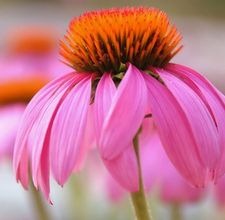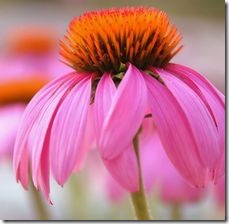The purple coneflower, also known as Echinacea purpurea, is a member of the aster family. Found throughout the United States and a few areas of Canada, this prairie flower can be grown in home gardens as well as in the wild. As a wildflower, the purple coneflower is primarily found in prairie habitats, and is often planted as part of prairie restoration gardening.
Description
-
The purple coneflower is a perennial flower that grows to an average height of 2 1/2 feet to 3 feet tall. According to the Illinois Wildflowers website, the flower features a distinctive center cone of disk florets ranging in color from yellow-brown to red-brown. Surrounding the center cone are light purple petals. The flower’s appearance is similar to a large daisy.
Distribution
-
The purple coneflower’s habitat consists of 27 U.S. states ranging from Florida and Northeastern Texas to Illinois and Iowa, according to the Lady Bird Wildflower Center’s website. Purple coneflowers are commonly found on the prairies of Minnesota and the midwestern United States. Coneflowers also thrive in western Canada.
Growing Conditions
-
The purple coneflower grows best in full or partial sun and fertile loam soil, according to the Illinois Wildflowers website. Home gardeners should know the plant is somewhat drought resistant but will wilt if soil dries out completely. It is rarely bothered by foliage or floral diseases when grown in the proper conditions.
Prairie Habitat
-
As previously stated, the purple coneflower is commonly used in prairie restoration projects, according to the Illinois Wildflowers website. A prairie is defined as an area with fertile soil, 90 percent sunny conditions, where native plants grow deep roots and become drought resistant. According to the Midwest Prairies LLC website, the prairie habitat of the midwestern United States was threatened by farming, overgrazing and human use. Today, many companies and home gardeners are attempting to restore prairie habitats by planting fields of native plants such as the purple coneflower.
Interesting Facts
-
As pioneers traveled west through America’s prairies, they nicknamed the purple coneflower the "Thirst Plant." The plant was named for its roots which produced a salty, peppery taste when consumed. Eating the purple coneflower’s roots helped reduce a traveler’s thirst when drinking water was not available. Planting this plant in a home garden may help attract hummingbirds and butterflies. The flower also has medicinal properties; according to the Lady Bird Wildflower Center’s website, it is a natural, mild antibiotic and may help prevent infection.


Deprecated: strpos(): Passing null to parameter #1 ($haystack) of type string is deprecated in /home/agriviek8Qv/agriviet.net/public_html/wp-includes/comment-template.php on line 2522